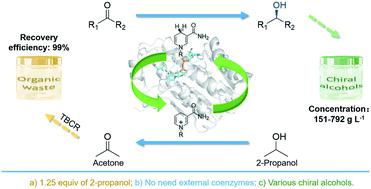当前位置:
X-MOL 学术
›
Catal. Sci. Technol.
›
论文详情
Our official English website, www.x-mol.net, welcomes your
feedback! (Note: you will need to create a separate account there.)
Efficient asymmetric synthesis of chiral alcohols using high 2-propanol tolerance alcohol dehydrogenase SmADH2 via an environmentally friendly TBCR system
Catalysis Science & Technology ( IF 4.4 ) Pub Date : 2019-11-05 , DOI: 10.1039/c9cy01794a Zeyu Yang 1, 2, 3, 4, 5 , Hengwei Fu 1, 2, 3, 4, 5 , Wenjie Ye 1, 2, 3, 4, 5 , Youyu Xie 1, 2, 3, 4, 5 , Qinghai Liu 1, 2, 3, 4, 5 , Hualei Wang 1, 2, 3, 4, 5 , Dongzhi Wei 1, 2, 3, 4, 5
Catalysis Science & Technology ( IF 4.4 ) Pub Date : 2019-11-05 , DOI: 10.1039/c9cy01794a Zeyu Yang 1, 2, 3, 4, 5 , Hengwei Fu 1, 2, 3, 4, 5 , Wenjie Ye 1, 2, 3, 4, 5 , Youyu Xie 1, 2, 3, 4, 5 , Qinghai Liu 1, 2, 3, 4, 5 , Hualei Wang 1, 2, 3, 4, 5 , Dongzhi Wei 1, 2, 3, 4, 5
Affiliation

|
Alcohol dehydrogenases (ADHs) together with the economical substrate-coupled cofactor regeneration system play a pivotal role in the asymmetric synthesis of chiral alcohols; however, severe challenges concerning the poor tolerance of enzymes to 2-propanol and the adverse effects of the by-product, acetone, limit its applications, causing this strategy to lapse. Herein, a novel ADH gene smadh2 was identified from Stenotrophomonas maltophilia by traditional genome mining technology. The gene was cloned into Escherichia coli cells and then expressed to yield SmADH2. SmADH2 has a broad substrate spectrum and exhibits excellent tolerance and superb activity to 2-propanol even at 10.5 M (80%, v/v) concentration. Moreover, a new thermostatic bubble column reactor (TBCR) system is successfully designed to alleviate the inhibition of the by-product acetone by gas flow and continuously supplement 2-propanol. The organic waste can be simultaneously recovered for the purpose of green synthesis. In the sustainable system, structurally diverse chiral alcohols are synthesised at a high substrate loading (>150 g L−1) without adding external coenzymes. Among these, about 780 g L−1 (6 M) ethyl acetoacetate is completely converted into ethyl (R)-3-hydroxybutyrate in only 2.5 h with 99.9% ee and 7488 g L−1 d−1 space–time yield. Molecular dynamics simulation results shed light on the high catalytic activity toward the substrate. Therefore, the high 2-propanol tolerance SmADH2 with the TBCR system proves to be a potent biocatalytic strategy for the synthesis of chiral alcohols on an industrial scale.
中文翻译:

使用高2-丙醇耐受性醇脱氢酶SmADH2通过环保的TBCR系统有效地不对称合成手性醇
醇脱氢酶(ADHs)与经济的底物偶联辅因子再生系统一起在手性醇的不对称合成中起着关键作用。然而,有关酶对2-丙醇的耐受性差以及副产物丙酮的不利影响的严峻挑战限制了其应用,从而导致了该策略的失效。本文中,通过传统的基因组挖掘技术从嗜麦芽单胞菌中鉴定出一种新的ADH基因smadh 2 。将该基因克隆到大肠杆菌细胞中,然后表达以产生Sm ADH2。mADH2具有较宽的底物谱,即使在10.5 M(80%,v / v)浓度下也表现出出色的耐受性和对2-丙醇的卓越活性。此外,成功设计了新型恒温鼓泡塔反应器(TBCR)系统,以减轻气流对副产物丙酮的抑制作用,并连续补充2-丙醇。为了绿色合成,可以同时回收有机废物。在可持续系统中,在不增加外部辅酶的情况下,以高底物负载(> 150 g L -1)合成结构多样的手性醇。其中,约780 g L -1(6 M)乙酰乙酸乙酯在2.5 h内具有99.9%ee和7488 g L -1 d完全转化为(R)-3-羟基丁酸乙酯。-1时空产率。分子动力学模拟结果揭示了对底物的高催化活性。因此,具有TBCR系统的高2-丙醇耐受性Sm ADH2被证明是工业规模合成手性醇的有效生物催化策略。
更新日期:2019-11-05
中文翻译:

使用高2-丙醇耐受性醇脱氢酶SmADH2通过环保的TBCR系统有效地不对称合成手性醇
醇脱氢酶(ADHs)与经济的底物偶联辅因子再生系统一起在手性醇的不对称合成中起着关键作用。然而,有关酶对2-丙醇的耐受性差以及副产物丙酮的不利影响的严峻挑战限制了其应用,从而导致了该策略的失效。本文中,通过传统的基因组挖掘技术从嗜麦芽单胞菌中鉴定出一种新的ADH基因smadh 2 。将该基因克隆到大肠杆菌细胞中,然后表达以产生Sm ADH2。mADH2具有较宽的底物谱,即使在10.5 M(80%,v / v)浓度下也表现出出色的耐受性和对2-丙醇的卓越活性。此外,成功设计了新型恒温鼓泡塔反应器(TBCR)系统,以减轻气流对副产物丙酮的抑制作用,并连续补充2-丙醇。为了绿色合成,可以同时回收有机废物。在可持续系统中,在不增加外部辅酶的情况下,以高底物负载(> 150 g L -1)合成结构多样的手性醇。其中,约780 g L -1(6 M)乙酰乙酸乙酯在2.5 h内具有99.9%ee和7488 g L -1 d完全转化为(R)-3-羟基丁酸乙酯。-1时空产率。分子动力学模拟结果揭示了对底物的高催化活性。因此,具有TBCR系统的高2-丙醇耐受性Sm ADH2被证明是工业规模合成手性醇的有效生物催化策略。











































 京公网安备 11010802027423号
京公网安备 11010802027423号